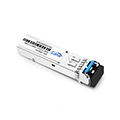The Fiber Bragg Grating (FBG) is an optical component that creates periodic changes in the refractive index within the fiber core through ultraviolet light exposure. When broadband light (such as the light pulse emitted by an OTDR, typically around 1650 nm in wavelength) passes through the FBG, a specific wavelength of light, known as the Bragg wavelength, is reflected back, while other wavelengths continue to transmit. This reflective characteristic makes the FBG an ideal signal marking point and fault detection tool in optical fiber networks.
In Passive Optical Network (PON) systems, FBG reflectors are usually installed on the Optical Network Unit (ONU) side to send reflected signals to the Optical Line Terminal (OLT). The OTDR on the OLT side monitors the status of the optical fiber line by emitting light pulses and detecting the signals reflected back by the FBG. If the reflected signal intensity is lower than normal, it may indicate a loss or fault in the line; if the reflection value is zero, it is likely that the fiber line has been cut.
By continuously monitoring the reflected signals from FBG reflectors in real-time, operators can quickly detect and locate issues within the fiber optic lines, enabling prompt repair actions to avoid service interruptions. This real-time monitoring mechanism is crucial for ensuring the stability and reliability of PON systems, especially in Fiber to the Home (FTTH) networks with a large number of users and complex network structures.

















































































 Ann
Ann












